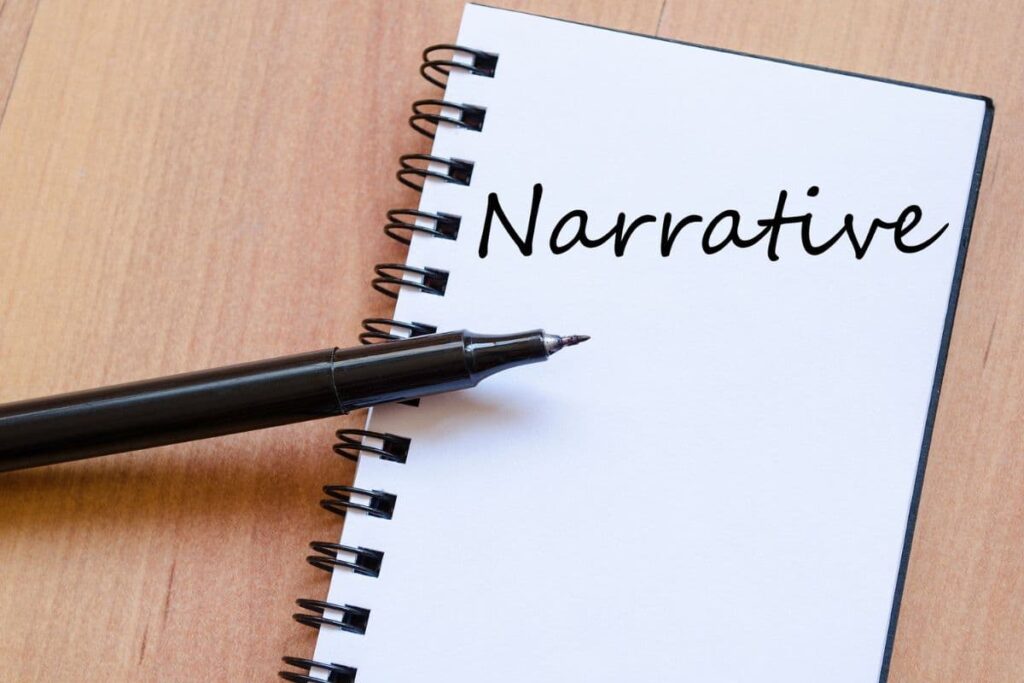A play script is distinctly different from a story or a novel, and both are considered narratives. But is a play script considered a narrative as well?
A play script can contain a narrative, which is a string of ordered events dictated by cause and effect with a group of characters, a setting or location, and a message or storyline. Narratives, and the majority of scripts, exist for entertainment and to give context to our lives.
On that note, this article will tell the story of what a narrative is, how play scripts fit into this category, and how narratives give our lives purpose and tell us more about who we are.

Play Scripts as Narratives
Play scripts frequently have:
- Backdrops that contextualize the events in the story.
- Characters that drive the story forward.
- Acts that frame conflict and resolution.
- A message stays with the audience even after the play ends.
Many narrative forms represent different forms of storytelling, as reflected in the table below:
| Narrative form | Description | Examples |
| Linear narrative | A story with a chronological plot that immerses the reader in the protagonist’s life. | Anna Karenina, Pride & Prejudice. |
| Non-linear narrative | A story that is purposefully told out of order to send a message, using flashbacks for example. | Forrest Gump, Wuthering Heights. |
| Viewpoint narrative | The story is told from one character’s point of view. | Fight Club, 1984, To Kill A Mockingbird. |
| Quest narrative | This is a story where the protagonist goes on a long journey to achieve a goal. | The Odyssey, Moby Dick, The Hobbit. |
Play genres work differently from narrative forms. One narrative form can encompass numerous play genres, and one title can fit into multiple categories.
For example, Forrest Gump is both a non-linear narrative and a viewpoint narrative.
The table below shows the different kinds of plays and play scripts and what their fundamental features are:
| Play genreDescriptionExamplesComedyComedy is recognizable by its creative language use and light-hearted tone. | A Midsummer Night’s Dream, Pride & Prejudice. | |
| Tragedy | A story that spirals out of control because of a protagonist’s fatal flaw. | Hamlet, Andromaque, Medea, The Glass Menagerie. |
| Epic theatre | A story that illustrates class struggles in a way viewers cannot relate to, to simultaneously distract and draw the audience’s attention. The Good Person of Szechwan, Man Equals Man, Mother Courage And Her Children. MelodramaOver-exaggerated plays with one-dimensional characters. They’re very dramatic and exciting. | Black-Eyed Susan, La Femme à deux maris. |
| Restoration | This focuses on the weak morals of the Court using satire and farce. | The Black Prince, The Country Wife. |
| Satire | Satire mocks individuals or organizations for their weaknesses or failures. | The Resistible Rise of Arturo Ui, Accidental Death of an Anarchist. |
| Musical | The story is told in a mix of song and dialogue where the music holds important plot devices. | West Side Story, Hamilton, The Wizard of Oz. |
Many sub-genres and overarching categories are involved in the play genres listed above.
Still, these seven are some of the most famous and commonly performed plays, both historically and in the modern age. As with narrative forms, plays can be a part of multiple genres.
For instance, Hamilton is both a musical and a comedy, and The Glass Menagerie is both a tragedy and a melodrama.
We can note numerous similarities and overlaps in the narrative and play categories. Quest narratives can occur within the context of comedy or tragedy. Many musicals are linear narratives, while satire is frequently non-linear.
Examples of this include:
- The Wizard of Oz is a musical with a linear story.
- The Glass Menagerie is a non-linear tragedy.
- Pride & Prejudice is a linear comedy.
The terminology is different, but these comparisons prove that the narratives and play scripts are inextricably linked. Play scripts should be informed by narrative forms, just as every other kind of narrative is.
What Is a Narrative?
A narrative is literarally a recounting of a series of connected events, that together form a story. Usually that story has a purpose, or message. The events in the story happen in order and for a particular reason. Little is random but rather the result of a cause-and-effect relationship. Most narratives have a message or lesson for the audience to take away from the story, when it’s all over.

Narratives have several attributes that closely link to those of play scripts:
- A set of characters: These characters have personalities, motivations, fears, and weaknesses and fill a role within a story. For example, to every protagonist, there is an opposing antagonist, both with their own identities and goals.
- A background or setting: Every narrative takes place somewhere, whether the environment is real or fictional. The backdrop of a narrative tells a story by giving background information on the characters or influencing the audience’s emotions.
- Conflict and resolution: Every ordered story has a beginning, middle, and end. There are multiple acts with build-up, conflict, or adversity, and how the characters overcome adversity or fall victim to it.
- An overall message: Even narratives that exist to make people laugh have a message. This may be as apparent as “jealousy is bad” or subversive as “time is fleeting, and indecision is deadly.”
When we think of narrative, the first thing that comes to mind is a fictional or historical story. If we evaluate what a narrative is, it becomes clear that it encompasses so much more:
- Folklore, myths, and legends
- Video games
- A series of artworks
- Journalism
- Scholarly writing, like essays and theses
This showcases the vast tones, messages, and mediums of the term narrative.
The Importance of Narratives
Everyone knows that humans need food and water to survive, but a lesser-known need is storytelling. This doesn’t keep us alive necessarily, but it keeps a record of our existence and informs who we’ll be in the future.
Narratives don’t only tell us things based on facts and logic, but they also explore philosophical and existential dilemmas that we can relate to or that make us question logic and facts.
Stories illustrate the struggles and success we all face:
- What a character wants.
- How they’re prevented from getting it.
- How they react to that.
Audience members can insert themselves into the story as the villain or the main character based on what they relate to or what narrative they enjoy the most.
How are the characters the same or different from each other and us as individual watchers? Are we being cautioned or encouraged? Narratives are a form of escapism, but they act as a microscope or mirror into the self.
Regardless of the message of a narrative, it’s a call to action for us to view our world as it is and compels us to feel a particular way about that and even to question it.
Conclusion
When compared side by side, it’s apparent that there is a strong and enduring relationship between play scripts and narratives. Most play scripts feature a narrative in some form, in fact, depending on your definition of narrative, it might be possible to say that all playscripts feature narratives!

